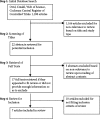Effectiveness of manual physical therapy for painful shoulder conditions: a systematic review
- PMID: 20140151
- PMCID: PMC2813507
- DOI: 10.1179/106698109791352076
Effectiveness of manual physical therapy for painful shoulder conditions: a systematic review
Abstract
Multiple disease-specific systematic reviews on the effectiveness of physical therapy intervention for shoulder dysfunction have been inconclusive. To date, there have been two systematic reviews that examined manual therapy specifically but both considered effects within diagnoses. The purpose of this systematic review was to identify the effectiveness of manual therapy to the glenohumeral joint across all painful shoulder conditions. A search of MEDLINE, CINAHL, Web of Science, and Cochrane Central Register of Randomized Controlled Trials for articles dated 1996 to June 2009 was performed. Inclusion for review were manual therapy performed to the glenohumeral joint only; non-surgical painful shoulder disorders; subjects 18-80 years; and outcomes of range of motion, pain, function, and/or quality of life. Quality assessment was performed using the PEDro scale with subsequent data extraction. Seventeen related articles were found with seven fitting the inclusion criteria. The average PEDro score was 7.86, meeting the cutoff score for high quality. Significant heterogeneity in outcome measures prohibited meta-analysis. Five studies demonstrated benefits utilizing manual therapy for mobility, and four demonstrated a trend towards decreasing pain values. Functional outcomes and quality-of-life measures varied greatly among all studies. Manual therapy appears to increase either active or passive mobility of the shoulder. A trend was found favoring manual therapy for decreasing pain, but the effect on function and quality of life remains inconclusive. Future research utilizing consistent outcome measurements is necessary.
Keywords: Glenohumeral Joint; Musculoskeletal Manipulations; Physical Therapy; Shoulder; Shoulder Pain.
Similar articles
-
Effectiveness of Glenohumeral Joint Mobilization on Range of Motion and Pain in Patients With Rotator Cuff Disorders: A Systematic Review and Meta-Analysis.J Manipulative Physiol Ther. 2023 Feb;46(2):109-124. doi: 10.1016/j.jmpt.2023.05.009. Epub 2023 Jul 8. J Manipulative Physiol Ther. 2023. PMID: 37422746 Review.
-
The effectiveness of manual therapy applied to craniomandibular structures in the treatment of temporomandibular disorders: protocol for a systematic review.Syst Rev. 2021 Mar 8;10(1):70. doi: 10.1186/s13643-021-01623-7. Syst Rev. 2021. PMID: 33685496 Free PMC article.
-
Does Cryotherapy Improve Outcomes With Soft Tissue Injury?J Athl Train. 2004 Sep;39(3):278-279. J Athl Train. 2004. PMID: 15496998 Free PMC article.
-
Efficacy of Manual Therapy on Pain, Impact of Disease, and Quality of Life in the Treatment of Fibromyalgia: A Systematic Review.Pain Physician. 2020 Sep;23(5):461-476. Pain Physician. 2020. PMID: 32967389
-
The future of Cochrane Neonatal.Early Hum Dev. 2020 Nov;150:105191. doi: 10.1016/j.earlhumdev.2020.105191. Epub 2020 Sep 12. Early Hum Dev. 2020. PMID: 33036834
Cited by
-
"Investigating the combined effects of scapular-focused training and Mulligan mobilization on shoulder impingement syndrome" a three-arm pilot randomized controlled trial.BMC Musculoskelet Disord. 2024 Nov 8;25(1):897. doi: 10.1186/s12891-024-07966-1. BMC Musculoskelet Disord. 2024. PMID: 39516846 Free PMC article. Clinical Trial.
-
Clinical effectiveness of manual therapy for the management of musculoskeletal and non-musculoskeletal conditions: systematic review and update of UK evidence report.Chiropr Man Therap. 2014 Mar 28;22(1):12. doi: 10.1186/2045-709X-22-12. Chiropr Man Therap. 2014. PMID: 24679336 Free PMC article.
-
Progressive Resistance Exercises plus Manual Therapy Is Effective in Improving Isometric Strength in Overhead Athletes with Shoulder Impingement Syndrome: A Randomized Controlled Trial.Biomed Res Int. 2021 Jun 30;2021:9945775. doi: 10.1155/2021/9945775. eCollection 2021. Biomed Res Int. 2021. PMID: 34307681 Free PMC article. Clinical Trial.
-
ORTHOPAEDIC MANUAL PHYSICAL THERAPY FOR POST-STROKE SHOULDER PAIN: TWO CASE REPORTS INCLUDING CLINICAL ASSESSMENTS AND PARTICIPANTS' EXPERIENCES.J Rehabil Med Clin Commun. 2025 Jun 3;8:43201. doi: 10.2340/jrm-cc.v8.43201. eCollection 2025. J Rehabil Med Clin Commun. 2025. PMID: 40510560 Free PMC article.
-
Effectiveness of Occupational Therapy Interventions for Musculoskeletal Shoulder Conditions: A Systematic Review.Am J Occup Ther. 2017 Jan/Feb;71(1):7101180020p1-7101180020p11. doi: 10.5014/ajot.2017.023127. Am J Occup Ther. 2017. PMID: 28027039 Free PMC article.
References
-
- AAOS American Academy of Orthopedic Surgeons . 2008. http://www.aaos.org. Accessed December 10,
-
- Cook C. Orthopedic Manual Therapy: An Evidence-Based Approach. Upper Saddle River, NJ: Pearson Prentice Hall; 2007.
-
- Kuijpers T, van der Windt D, Boeke AJ, et al. Clinical prediction rules for the prognosis of shoulder pain in general practice. Pain. 2006;120:276–285. - PubMed
LinkOut - more resources
Full Text Sources
Medical

